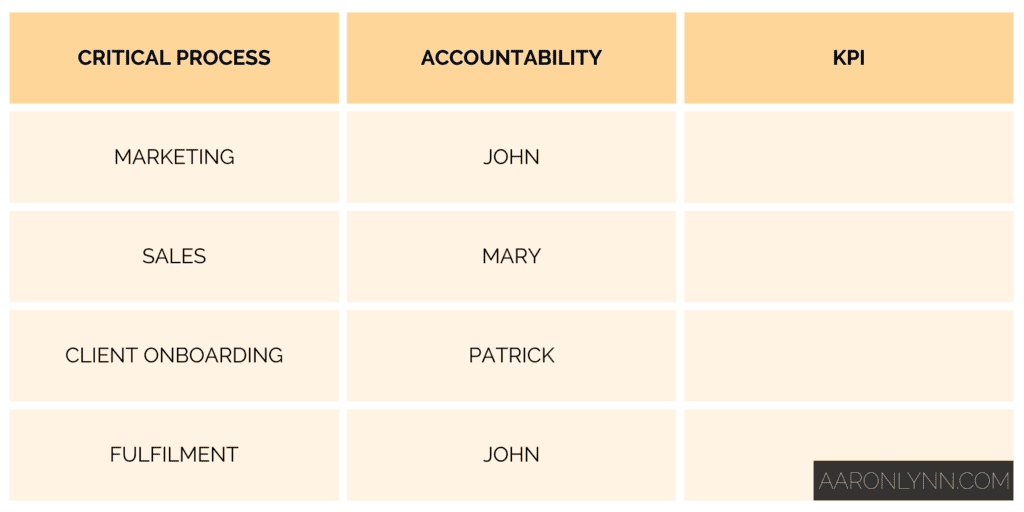
The transition from being a solopreneur to being a business owner with a team is tough.
It is even tougher to form a solid leadership team that is capable of helping you run the business and grow it without being 100% reliant on your effort.
Usually, one of two things will happen as your business grows.
If it’s been planned ahead of time, you bring onboard the right mix of junior and senior people, and the company grows naturally in the right direction.
If it hasn’t been planned well ahead of time, then business owners tend to bring onboard a lot of junior people. This is due to their lack of trust in others’ abilities, or lack of trust with sensitive information like financials. Companies like this end up with a business owner at the top, and a plethora of low-skilled workers at the bottom, and hit a growth and management ceiling.
This leads us to ask:
- Why do we need a leadership team?
- What does a good leadership team look like?
- What makes a good leadership team member?
- What do we do with our leadership team?
- How can companies in different situations go about forming their own leadership teams?
What Does a Good Leadership Team Look Like?
Let’s start with the first two:
- Why do we need a leadership team?
- What does a good leadership team look like?
A good leadership team helps you, as the business owner, lead and manage the company better.
Think about the stereotypical business owner you know.
They’re running around, making big decisions, trying to close key accounts, occasionally dipping into the technical work, and on top of it all, trying to manage and corral the team daily.
They are the antithesis of being “energised, focused and well-rested”.
And this is why you need a leadership team in your business.
A leadership team in a small business, is responsible for management and execution.
This means that you can make executive-level decisions about the future of the company, then pass over the implementation and execution to the leadership team, who will make it happen.
You set the vision, the leadership team turns it into reality.
And as a result, you, as the business owner, are well-rested, and have the mental, temporal and physical space to spend more time thinking strategically about the future of the company.
How does this actually look?
A good leadership team in a small business consists of:
- You as the CEO/founder of the company.
- Heads of departments.1Or pillars, or areas, or teams.
- A couple of highly skilled technicians who are on the leadership team for their technical depth and expertise.
The leadership team should provide full coverage across all critical process and business functions.
In other words, every “Who” box on these charts should have a name assigned:2And no one person should be accountable for too many things.
It is better to think of this as the “key roles” that make up a leadership team, rather than the traditional corporate-level CEO, CFO, CMO etc.
What Makes a Good Leadership Team Member?
By definition, a good leadership team member is capable of taking accountability for a critical process or function within the business.
Beyond that, it is useful for them to have some managerial capability. That is, the ability to determine the strengths and weaknesses of team members and assign tasks accordingly.
Some leadership capability is also warranted. This is the ability to unify people around a singular vision and path forward,3i.e., company values and mission. though this is less important unless they are also the General Manager or CEO in place of you.
Leadership team members must also have some technical skill. This will make team members respect them more, which in turn will make management easier. It also means they will be able to jump in and help with frontline work so that you don’t have to.
Standard project management skills are also expected. They must be able to use the apps and systems, and also plan, start, manage and drive the completion of projects.
They must also strongly display and champion company values and the company mission.
And of course, they should work well with you and preferably complement your strengths and weaknesses.
What Do You Actually Do With Your Leadership Team?

Once you have assembled your leadership team — what do you actually do together?
The first two things are to make sure that your process accountability chart and functional accountability chart are correctly filled out.
Then you want to integrate them into your real-time meeting rhythm:
- A daily leadership team huddle (as a round up for all other daily team huddles).
- Having the entire leadership team present for all weekly meetings. Or, if the company is big enough, having a separate leadership team meeting.
- In and leading your monthly meeting. Leadership team members should help evaluate the show-and-tell parts of this meeting, and also deliver training as a form of knowledge transfer to frontline team members.
- Alongside you for strategic planning during quarterly and annual meetings.
Your leadership team will also act as your sounding board for making major business decisions. You lean on their expertise, perspective and experience, and then decide.4Because a small business is still a benevolent dictatorship.
You will want to invest in their personal and professional development. This means managerial training, leadership training, taking an interest in their personal lives and helping them resolve conflicts there, and taking them to key meetings with partners, vendors and important clients.
Day-to-day, they act as your eyes and ears at the frontline level of the company and provide you with direct team and market feedback.
How Do I Formulate My Leadership Team?
There are usually three common scenarios for forming a leadership team:
- Skilled Potential: The business has 10+ people and has skilled people onboard, but there is no formalised leadership team.
- Apex Structure Mistake: The business has 10+ people, but only frontline workers onboard, with you running everything else.
- Advanced Planning: The business is still growing, and you’d like to plan your leadership team correctly from the start.
Let’s look at how to handle each of these scenarios.
Scenario 1: Skilled Potential

The Skilled Potential scenario usually happens where a company has grown over time, usually to 10+ team members, and no real thought has been given to its operational structure.
There is a good mix of junior and senior people in the company, but there are no regular meetings of senior people — yet.
This typically happens when the CEO/founder is a workaholic and likes having close control of everything, and is running around doing far too many things.
This seems bad, but is actually the best place to be for developing a leadership team, apart from already having a solid leadership team in place.
The first thing to do here is to fill out your process and functional accountability charts.
Start by assigning critical process and functions to department heads. And for any remaining roles, ask if there are any non-managers who can be accountable for those — there usually will be, and they will usually be skilled frontline technicians.
Note: Some companies are organised by regional offices, in which case the leadership team can be comprised of the heads of each office.
Once the accountability charts have been filled in — that’s your leadership team.
Scenario 2: Apex Structure Mistake

The second scenario is the Apex Structure Mistake, and this usually happens to self-funded solopreneurs with online companies.
They start their business and then hire a lot of freelancers/VAs/low-skilled labour from Upwork and similar places.
They aren’t willing to invest in systemisation, delegation or well-paid senior people, and thus the financials, management, systems and administrative tasks all remain in their hands. They likely also have trouble trusting others/letting go of these functions.
This results in a company that has one CEO/business owner and 20+ frontline delivery people, with few/none capable of managing or leading.
This is obviously a problem.
It is extremely difficult to elevate someone from the most junior position in the company (and who is probably underpaid) into a leadership position.
They simply do not have enough skin in the game in terms of compensation or respect. And, the entire employment frame has been, “you are a frontline worker, not management material”.5That may not seem fair or politically correct, but that’s how it works in terms of psychology.
So, what can we do?
The first thing is to take a hard and detailed look at the existing staff.
MAYBE there is some potential there.
For example, anyone who has:
- Expressed interest in doing something apart from the day-to-day work.
- Has shown some leadership potential through trial work and once-off tasks.
If you put any of these employees onto the leadership team, be prepared to:
- Pay them more.
- Provide them with a lot of training in managerial and leadership skills. And I do mean a lot.
- Respect their opinions.
This is an extremely difficult task, mainly because everyone on the team is used to the apex structure that was in place. Most business owners I have helped with this find that no one on their team is actually suitable, which brings us to our second option.
And that is to hire from outside the company.
You want to find these types of people:
- Online business managers.
- Fractional executives.
- People with managerial experience (i.e., they have had people report to them before).
- More senior technical people who would like to try managing others.
And be prepared to compensate them at managerial levels for their work.
Whoever you bring onboard for a leadership team role needs to actually work in the business — they must deliver work, and manage projects and departments. You are bringing them on to work first, and be part of the leadership team second.
The truth is escaping the Apex Structure Mistake is very, very difficult and there are no real secrets here, you simply have to do the best you can with what you have.
Scenario 3: Advanced Planning

The final scenario is the Advanced Planning scenario.
This is for business owners who may have a much smaller team of say four people, and want to “plan and do it right”.
If you are one of these business owners, here’s how you should proceed.
You should hire as the business needs.
And you should not be afraid to hire more senior or experienced people. This will help you avoid the Apex Structure Mistake scenario where you end up with a team of only $4/hour VAs.
Don’t expect any “experienced hires” to be 100% functional on day one — they still need to be trained in how things are done at the company, but they will be productive much faster than a junior hire.
You should also invest in developing all your people into more senior people. Send them to trainings and have them take online courses. Pass down your knowledge to them regularly.
Every now and then, see who has management potential by giving them semi-managerial tasks here and there. For example, “Go and find us a freelancer on Upwork who does XYZ.”
You will, of course, also want to start drawing out your critical process and functional accountability charts. In the beginning, most of the boxes are going to have your name in them, but that will change over time.
As the team passes the 7+ people mark, you can start organising a leadership team.
It may just be you and one manager to start, but will grow as more people join the company.
Add them to the accountability charts and spin up a real-time meeting rhythm.
Get Your Leadership Team Onboard with Company Culture
In order to get your leadership team on the same page as you, they need to believe in the company culture.
And for that to happen, you have to have a company culture.


The easiest way to do that is to grab my Company Culture Cheatsheet and use it to rapidly write up what the company’s mission and values are, and how its goals can support that.
Grab it here:
What To Do Next
Work out which scenario best fits your business, and then follow the action steps to start formulating your leadership team.
Grab the Company Culture Cheatsheet to accelerate the process.
And if you need a bit more expert help in working this all out, book your free discovery call with me.
I have recently helped companies in all three Skilled Potential, Apex Structure and Advanced Planning scenarios navigate their way to a solid leadership team, and will be able to help you too.
- Or pillars, or areas, or teams.
- And no one person should be accountable for too many things.
- i.e., company values and mission.
- Because a small business is still a benevolent dictatorship.
- That may not seem fair or politically correct, but that’s how it works in terms of psychology.

